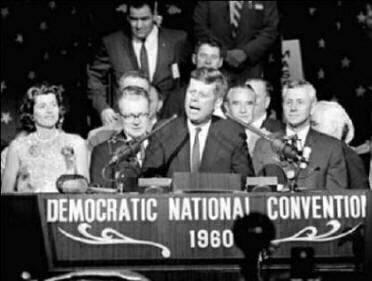On July 13, 1960, Democratic Senator John F. Kennedy won his party’s nomination at a Los Angeles convention by leveraging the system of primary elections as a new factor in presidential campaigning.
 To be sure, Kennedy and his team had to heavily lobby local and national political bosses to get enough votes at the convention to win a first-ballot nomination. But his performance in the West Virginia primary made voter-driven state primaries a new force in the constitutional process of selecting a President.
To be sure, Kennedy and his team had to heavily lobby local and national political bosses to get enough votes at the convention to win a first-ballot nomination. But his performance in the West Virginia primary made voter-driven state primaries a new force in the constitutional process of selecting a President.
The Founding Fathers envisioned a much-different process of selecting a chief executive. In the original system, a convention of state delegates chose electors to represent their interests in the electoral college. The top two vote getters in the electoral college became President and Vice President. (The Constitution didn’t establish procedures beyond that for the nomination of presidential candidates.)
The system worked for two elections when George Washington was a unanimous choice for President; it quickly fell apart when political parties formed after Washington wasn’t President.
In 1804, the 12th Amendment required separate votes for presidential and vice presidential candidates, after the disastrous 1800 election and House runoff election between Thomas Jefferson and Aaron Burr. Congressional caucuses were then used to pick presidential and vice presidential candidates.
But within three decades, national nomination conventions replaced congressional caucuses as the method for choosing party nominees for President. Another House runoff in 1824 between John Quincy Adams and Andrew Jackson led to a renewed desire for state party leaders to have a bigger say in the process.
The national party convention system stood unchallenged until the 1970s, but the first presidential primaries began in the early 1900s as part of the Progressive movement. By 1916, 20 Democratic and Republican parties had primary elections, but they had little impact on how political bosses chose convention delegates and influenced conventions.
The primary system came back into play gradually after World War II. Incumbent President Harry S. Truman lost in the 1952 New Hampshire presidential primary, amid poor popularity numbers, and dropped from the race. Senator Estes Kefauver won 12 of 15 Democratic primaries, but the Democratic convention chose Adlai Stevenson, who skipped the entire primary season.
At that time, Kennedy was six years into his political career. In 1946, he ran for the House of Representatives at the age of 29 and won. His older brother had been expected to be the family’s political standard bearer, but he was killed in action during World War II.
Kennedy was elected three times to the House and two times to the U.S. Senate before deciding to run for president in 1960. During the 1960 primary season, 648 convention delegates would be selected in a binding primary process including 17 states and the District of Columbia.
But Kennedy only ran in 10 primaries, and he would need 761 votes to gain the nomination. The West Virginia primary became his campaign’s focus, because it would prove that Democrats in a heavily Protestant state would vote for a Catholic candidate. Kennedy had a respected opponent in Hubert Humphrey.
Washington Post columnist David Broder recalled the primary in a 2010 article on the 50th anniversary of the election. Polls showed Kennedy leading by a 4-1 margin in West Virginia until religion became an issue, and he trailed by a 3-2 margin in the weeks before the election.
“It was a crucial test for the ‘religious issue’ in American life, measuring whether West Virginia, heavily Democratic but overwhelmingly Protestant, would support a Roman Catholic, Kennedy, for president,” Broder said.
In the end, Kennedy aggressively campaigned and used the media in a modern fashion to dominate Humphrey in the West Virginia primary. But the hard work of winning the nomination would come in the run to, and at the convention, when Stevenson and Lyndon Johnson, who bypassed the primary process, sought to win the nomination on the floor.
So 0n July 13, 1960, Kennedy narrowly won a first-ballot nomination when Wyoming, the last state in the alphabetical roll call, put him over the top. While not relying on the primary system for his nomination, Kennedy's performance in West Virginia made them relevant.
The final crack in the traditional convention process came eight years later at the 1968 Democratic convention in Chicago. Candidate Eugene McCarthy, who won the most primary votes, lost to Humphrey in the delegate count. Humphrey had not run as an announced candidate in the 17 primaries, and only 38 percent of convention delegates were chosen by voters in primaries. (Republicans picked just 34 percent of delegates in primaries.)
Both parties soon initiated reforms to ensure that more voters had a direct role in choosing political nominees. In 1976, Democrats selected 73 percent of convention delegates in primaries, while Republicans chose 68 percent. Today, most delegates are selected in the primary process, with the exception of Super Delegates or automatic delegates who are current or former party leaders.







